Team Discovery Channel INEN 420 December 2, 2004
advertisement
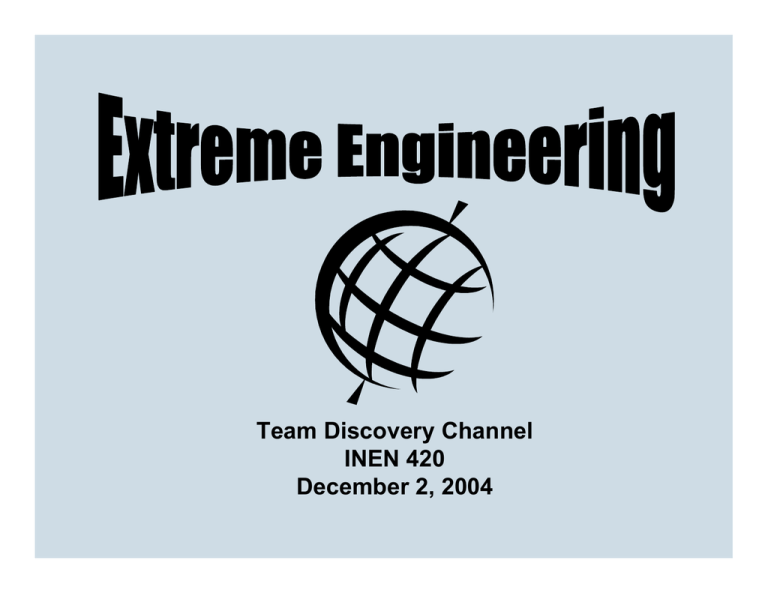
Team Discovery Channel INEN 420 December 2, 2004 Grummins Trucks • The goal of this problem is to maximize the profit of Grummins Engine Company over the next three years • Decision Variables – Si,j = number of type i trucks sold in year j – Xi,j = number of type i trucks produced in year j – Ii,j = number of type i trucks held in year j Formulation Objective Function: MAX Z=20000(s11+s12+s13) + 17000(s21+s22+s23) – 15000(x11+x12+x13) -14000(x21+x22+x23) -2000(I11+I12+I21+I22) Constraints: Production Truck 1 Inventory Control Truck 2 Inventory Control x11+x21<=320 x12+x22<=320 x13+x23<=320 x11>=s11 x11-s11=I11 x12+I11>=s12 x12+I11-s12=I12 x13+I12>=s13 x21>=s21 x21-s21=I21 x22+I21>=s22 x22+I21-s22=I22 x23+I22>=s23 Demand Constraints s11<=100 s12<=200 s13<=300 s21<=200 s22<=100 s23<=150 Emissions Constraints Non-negative (15(x11+x12+x13)+5(x21+x22+x23)) Si,j=>0 Xi,j=>0 Ii,j=>0 <=10 (x11+x12+x13+ x21+x22+x23) Solution •Max Profit: $3,600,000 •7 iterations using LINDO Sensitivity Analysis SA table gives the maximum amounts that which the objective function coefficients and right-hand side values (objective function and constraints) could increase or decrease with the current basis remaining optimal. NBV coefficients could decrease infinitely or increase by 2000 (inventory costs) All the coefficients for variables representing all trucks sold except for type 1 year 3 can increase infinitely (continue to maximize profits with same basis) Final Say •Type 1 recommendations -Sell 100 in year 1 - 200 in year 2 - 150 in year 3 •Type 2 recommendations - Sell 200 in year 1 - 100 in year 2 - 150 in year 3. •We recommend that no inventory be held for this system •A suggestion would be to decrease the pollution levels of truck type 1; this might increase our profit sales for year 3. Wheaties •Goal is to maximize profits over the next 10 months •Decision Variable - Si = number of bushels (x1000) sold in month i - Bi = number of bushels (x1000) bought in month i - Ii = initial stock of bushes (x1000) for month i Formulation Objective Function: max Z =3S1+6S2+7S3+S4+4S5+5S6+5S7+s8+3S9+2S10-8B1 -8B2-2B3-3B4-4B5-3B6-3B7-2B8-5B9-5B10 Constraints: I1=6 S1<=I1 (I1-S1)+B1<=20 (I1-S1)+B1=I2 S2<=I2 (I2-S2)+B2<=20 (I2-S2)+B2=I3 S3<=I3 (I3-S3)+B3<=20 Non-negative Si=>0 Bi =>0 Ii =>0 (I9-S9)+B9=I10 S10<=I10 (I10-S10)+B10<=20 Solution •Max Profit is $162 •27 iterations using LINDO Sensitivity Analysis •S1 (amount of bushels sold in month 1) could decrease infinitely or increase by 4 to still keep the same basis. •This means to increase the selling price up to 7 or decrease to 0, since the selling price should be non-negative. •We cannot increase the selling price infinitely on all S variables because in this problem, some months have a higher purchasing price than selling price. •Increasing infinitely on NBV selling coefficients (Si) would change the basis by making the selling price higher than the purchasing price for those months Final Say •Month 8 and 10 held no inventories. •Amount sold in month 1, 2, 4, and 5 was less than the initial inventory. •We recommend buying when the purchasing price is less than the selling price, such as month 3 and 6. •Increasing out warehouse capacity will increase our profits. T-Back, Inc. T-Back Inc. is a supplier of luxury thongs to Victoria Secret. Considering transportation costs, demand, and selling prices, T-Back Inc. has hired us to maximize their profits for the upcoming holiday season. Decision Variables • Xi,j=number of thongs shipped to demand point i to supply point j Demand 1) San Francisco 2) New York 3) Chicago 4) Dallas 5) Los Angeles 6) Las Vegas Supply (1)New Orleans (2) Seattle (3) Miami (4) Houston Formulation -Their trucks can hold up to 100 thongs, but we only pay for the •space we take up (shipping costs/thong). -The national average as of 11/29/04 for diesel gas prices per gallon is $2.11 max Z= 40(X11+X12+X13+X14)+42(X21+X22+X23+X24)+36(X31+X32+X33+X34)+20(X41+X42+X43+X 44)+33(X51+X52+X53+X54)+19(X61+X62+X63+X64)-2.1285X11-8.229X12-6.1929X135.0851X14-7.5380X21-3.4235X22-3.4499X23-4.3255X24-5.4359X31-3.8402X32-2.4423X333.1676X34-5.7999X41-3.5976X42-1.3715X43-.6304X44-2.9962X51-7.2294X524.9954X534.0855X54-3.3153X61-7.0632X62-4.8372X63-4.1013X64 Demand Constraints X11+X12+X13+X14<=100 X21+X22+X23+X24<=250 X31+X32+X33+X34<=50 X41+X42+X43+X44<=75 X51+X52+X53+X54<=150 X61+X62+X63+X64<=300 Supply Point Constraints Non-negative Constraints X11+X21+X31+X41+X51+X61<=300 Xi,j for i=1…6 and j=1…4 are >=0 X12+X22+X32+X42+X52+X62<=300 X13+X23+X33+X43+X53+X63<=150 X14+X24+X34+X44+X54+X64<=175 Solution •Our Profit was $25,391.08 •16 iterations using LINDO Sensitivity Analysis Example: The basic variable coefficient of x22 can increase indefinitely and decrease by 2.25. Below 36.32 (38.57-2.25), the profit margin is too small, changing the basis. However, increasing the coefficient indefinitely will just increase our max profit (z) and not change the basis Final Say •All our demand was met; and all our supply points were capitalized. •Seattle fed all of San Francisco’s and Los Angeles’s demand. This makes sense since the distance is smaller, and therefore the cost of transportation is reduced. New York’s and Chicago’s demand is fed by Miami; Dallas demand is taken care of by Houston. The major provider for Las Vegas is New Orleans with support from Seattle and Houston. •Increasing the thong demand of our most profitable cities, decreasing transportation costs by increasing trucking capacity, and moving to a more opportune location to reduce mileage will increase our profits. Overall Conclusion •Formulations were the easy part; recognizing what LINDO gave us in the analysis was a little bit more complicated •We could have used EXCEL Solver for these problems •All our variables needed to be discrete (integer) since divisibility assumption is not met •All other assumptions were assumed (additivity, proportionality, and certainty) •We could have played with the coefficients and the constraints more to see which variables could have the biggest impact on profits if small changes were made
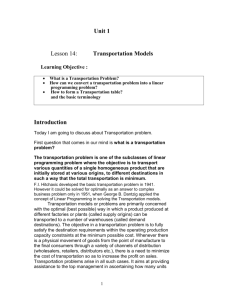
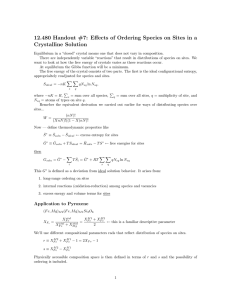
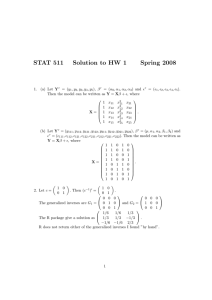
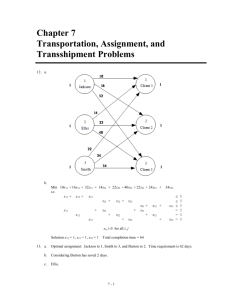
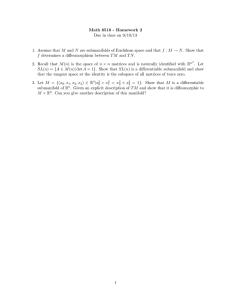
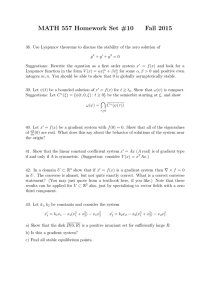
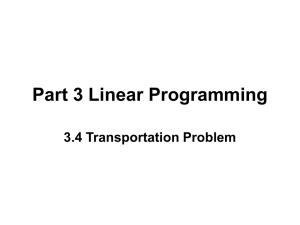
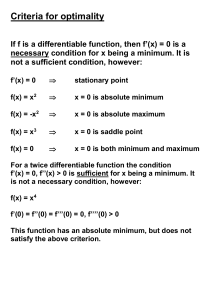
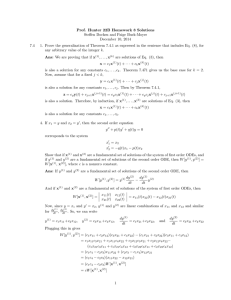
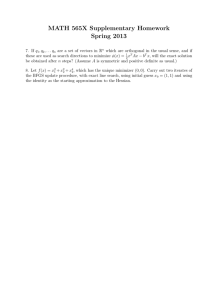
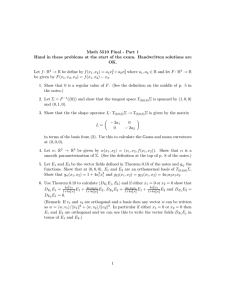
![[ ]](http://s2.studylib.net/store/data/013590594_1-e2fe91ced984fc8c9bf9d956b855440e-300x300.png)